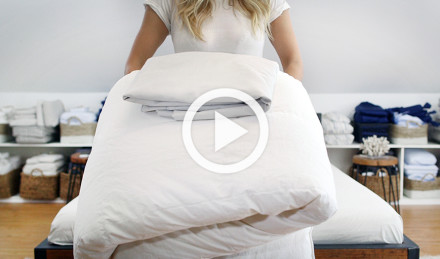You’re dozing off while watching Netflix, so you scurry to bed to take advantage of that sleepy feeling. Suddenly you find yourself wide awake – your mind swimming with worries and plans. You feel so frustrated – you were sleepy just a minute ago! If this sounds familiar to you, you may be one of the estimated 30% of the adult population suffering from insomnia.
The experience of insomnia varies widely but is defined by experts as either difficulty falling or staying asleep, waking up too early, or feeling unrefreshed despite adequate time asleep.
In an attempt to get better sleep, some turn to desperate measures: Cocktails of medications, refusing to share a bed, hypnosis, sleepy time teas, daily naps. But these prove ineffective and can even exacerbate the problem. So we asked Dr. Angela Lachowski, Ph.D., C. Psych (Supervised Practice), for a healthy solution so you can get back to enjoying your time between the sheets. Good news: She can help…
For those suffering insomnia, there is a rational, biologically-based, evidence-supported technique that works well and works permanently, if people continue to use it: Cognitive Behavioral Therapy for Insomnia, or CBT-I. CBT-I uses both behavioral techniques and cognitive strategies for targeting symptoms of insomnia. The program usually begins by logging your sleep for two weeks in order to target your specific difficulties. A therapist can then help you identify problem behaviors or thoughts and make recommendations about how to modify them. Here are some of the main techniques:
Recognize That Your Sleep Needs are Unique
There is a general misconception that adults need 8 hours of sleep to function optimally. While this may be true for some people, it is absolutely not true for many. Our unique sleep needs vary from person to person in both duration (how many hours your body produces) and timing (when your biological clock dictates sleep and wakefulness during the 24 hour day – this is known as your circadian rhythm). If your biological clock has determined that you are a six hour sleeper (a completely fine total sleep time), and you try to sleep over eight hours, consequences will include long pockets of wakefulness and lightened overall sleep quality – a recipe for insomnia!
Use a sleep log to mathematically determine how much sleep your body requires and the timing of your natural circadian rhythm (what time your body starts producing sleepy signals and wakeful signals). The schedule your time in bed to be within half an hour of that timing. Our sleep system is just like our heart or our lungs – designed to support a healthy body.
Recognize That Your Sleep Needs are Unique
There is a general misconception that adults need 8 hours of sleep to function optimally. While this may be true for some people, it is absolutely not true for many. Our unique sleep needs vary from person to person in both duration (how many hours your body produces) and timing (when your biological clock dictates sleep and wakefulness during the 24 hour day – this is known as your circadian rhythm). If your biological clock has determined that you are a six hour sleeper (a completely fine total sleep time), and you try to sleep over eight hours, consequences will include long pockets of wakefulness and lightened overall sleep quality – a recipe for insomnia!
Use a sleep log to mathematically determine how much sleep your body requires and the timing of your natural circadian rhythm (what time your body starts producing sleepy signals and wakeful signals). The schedule your time in bed to be within half an hour of that timing. Our sleep system is just like our heart or our lungs – designed to support a healthy body.
Use the Bed Only for Sleep (and Sex)
Remember learning about Pavlov’s dogs in psychology class? Humans aren’t so different from dogs; we can be conditioned to a repeated stimulus in the exact same way. Imagine that, night after night, you lie awake in bed either playing on your phone, tossing and turning, or planning and worrying about the next day. The bed and bedroom environment will subconsciously become the place you engage in these wakeful activities. The solution: Whenever you find that you are wide awake or feeling distressed in bed, get up, move to another room (or place in the room), and do something pleasant (but avoid the computer and blue light devices). You can’t sleep anyway, so why force it? Think of this wakefulness as an investment into your quality of sleep the next night. Your sleep drive will have extra incentive tomorrow to produce good quality sleep.
Use the Bed Only for Sleep (and Sex)
Remember learning about Pavlov’s dogs in psychology class? Humans aren’t so different from dogs; we can be conditioned to a repeated stimulus in the exact same way. Imagine that, night after night, you lie awake in bed either playing on your phone, tossing and turning, or planning and worrying about the next day. The bed and bedroom environment will subconsciously become the place you engage in these wakeful activities. The solution: Whenever you find that you are wide awake or feeling distressed in bed, get up, move to another room (or place in the room), and do something pleasant (but avoid the computer and blue light devices). You can’t sleep anyway, so why force it? Think of this wakefulness as an investment into your quality of sleep the next night. Your sleep drive will have extra incentive tomorrow to produce good quality sleep.
Keep Your Worries Out of Your Bed
Our minds were designed to think, but we are often distracted by daily worries. Then you get into bed, and these thoughts start racing when all other distractions are removed. Fortunately, the solution is simple, although initially unpleasant. Get out of bed and go do something relaxing until you feel sleepy again. You can read, write, stretch, listen to calming music, sketch or color, complete a puzzle or even watch TV (but do not use a laptop or tablet to view your favorite show). Then return to bed. For the first night, this process of getting up when your mind becomes active in bed may happen several times – that’s okay, because you are increasing your sleep drive for the next night. Eventually your drive for sleep will trump your anxiety, pushing your body to produce sleep more easily during the time that you want it.
Keep Your Worries Out of Your Bed
Our minds were designed to think, but we are often distracted by daily worries. Then you get into bed, and these thoughts start racing when all other distractions are removed. Fortunately, the solution is simple, although initially unpleasant. Get out of bed and go do something relaxing until you feel sleepy again. You can read, write, stretch, listen to calming music, sketch or color, complete a puzzle or even watch TV (but do not use a laptop or tablet to view your favorite show). Then return to bed. For the first night, this process of getting up when your mind becomes active in bed may happen several times – that’s okay, because you are increasing your sleep drive for the next night. Eventually your drive for sleep will trump your anxiety, pushing your body to produce sleep more easily during the time that you want it.
Wake Up at the Same Time Every Day
If you’ve ever had jet lag, you know the symptoms – fatigue, irritability, feeling hungry at strange hours, mental fogginess. Jet lag isn’t caused by airplane travel, but by the difference between the clock in your body and the clock on the wall. So if you wake up at different hours throughout the week, you could be flying across the country without ever actually leaving your home. The more regular you are with your wake time, the more regular your natural circadian rhythm will be – unfortunately your body doesn’t know the difference between a week day and a weekend. If you happen to have a poor sleep one night, think of that sleep loss as an investment into the next night’s sleep – your body will compensate to take care of itself. It’s a beautiful system if you allow it to work as it should.
Wake Up at the Same Time Every Day
If you’ve ever had jet lag, you know the symptoms – fatigue, irritability, feeling hungry at strange hours, mental fogginess. Jet lag isn’t caused by airplane travel, but by the difference between the clock in your body and the clock on the wall. So if you wake up at different hours throughout the week, you could be flying across the country without ever actually leaving your home. The more regular you are with your wake time, the more regular your natural circadian rhythm will be – unfortunately your body doesn’t know the difference between a week day and a weekend. If you happen to have a poor sleep one night, think of that sleep loss as an investment into the next night’s sleep – your body will compensate to take care of itself. It’s a beautiful system if you allow it to work as it should.
Check Your Expectations About Sleep
There are a lot of misconceptions that pressure us to strive for “perfect” sleep. Most of these are blatantly false and actually worsen our sleep. Did you know, we wake up an average of 12 times an hour? So recalling a few short wake-ups throughout the night is perfectly normal.
Another misconception: Many people think that REM (rapid eye movement sleep) is our most restorative sleep stage. However, it’s actually slow-wave sleep (in abundance only in the first half of the night) that serves the most restorative sleep function. Sleeping in actually leads to over-production of REM sleep, which makes us feel more tired and even depressed. These are just two examples – educating yourself about “normal” sleep (from a reliable source) will help with setting reasonable expectations for yourself about what constitutes good sleep.
Check Your Expectations About Sleep
There are a lot of misconceptions that pressure us to strive for “perfect” sleep. Most of these are blatantly false and actually worsen our sleep. Did you know, we wake up an average of 12 times an hour? So recalling a few short wake-ups throughout the night is perfectly normal.
Another misconception: Many people think that REM (rapid eye movement sleep) is our most restorative sleep stage. However, it’s actually slow-wave sleep (in abundance only in the first half of the night) that serves the most restorative sleep function. Sleeping in actually leads to over-production of REM sleep, which makes us feel more tired and even depressed. These are just two examples – educating yourself about “normal” sleep (from a reliable source) will help with setting reasonable expectations for yourself about what constitutes good sleep.
Refrain From Napping
Naps can be so delicious – who doesn’t love a Sunday mid-afternoon snooze? Unfortunately, unless you are seriously sleep-deprived (like new mothers) or worried about your safety (you need to drive and feel super sleepy), then naps serve a number of counterintuitive purposes. For one, after a nap, your drive to produce sleep that night is likely not going to be strong enough to produce restorative sleep for the duration that you want it. Naps also confuse your body’s natural circadian rhythm. Remember it’s quite normal to feel more tired in the afternoon after lunch, when our body temperature drops slightly. Tackle this fatigue by going for a walk, getting some light and breathing fresh air – you will feel far better than if you give in and take a nap.
Refrain From Napping
Naps can be so delicious – who doesn’t love a Sunday mid-afternoon snooze? Unfortunately, unless you are seriously sleep-deprived (like new mothers) or worried about your safety (you need to drive and feel super sleepy), then naps serve a number of counterintuitive purposes. For one, after a nap, your drive to produce sleep that night is likely not going to be strong enough to produce restorative sleep for the duration that you want it. Naps also confuse your body’s natural circadian rhythm. Remember it’s quite normal to feel more tired in the afternoon after lunch, when our body temperature drops slightly. Tackle this fatigue by going for a walk, getting some light and breathing fresh air – you will feel far better than if you give in and take a nap.
Sleep Hygiene: It’s Necessary but not Sufficient
If you’ve been experiencing sleep problems, you probably found Dr. Google’s most common recommendation: Sleep hygiene. This usually involves suggestions about limiting caffeine and alcohol, getting exercise, and having a quiet, dark, comfortable and cool bedroom environment. These practices are not enough to fix insomnia, but messing with any of these (e.g. too much alcohol before bed) will interfere with quality sleep.
It’s most important to recognize that no one’s sleep is perfect – even sleep therapists have insomnia some nights! However, follow these simple strategies, and you will be well on your way to obtaining good quality sleep over the long term.
Sleep Hygiene: It’s Necessary but not Sufficient
If you’ve been experiencing sleep problems, you probably found Dr. Google’s most common recommendation: Sleep hygiene. This usually involves suggestions about limiting caffeine and alcohol, getting exercise, and having a quiet, dark, comfortable and cool bedroom environment. These practices are not enough to fix insomnia, but messing with any of these (e.g. too much alcohol before bed) will interfere with quality sleep.
It’s most important to recognize that no one’s sleep is perfect – even sleep therapists have insomnia some nights! However, follow these simple strategies, and you will be well on your way to obtaining good quality sleep over the long term.




